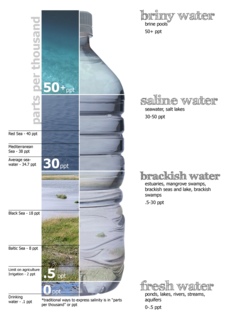高盐湖泊
外观

| 水的盐度 |
|---|
 |
| 盐度 |
|
淡水(<0.05%) 半咸水(0.05–3%) 盐水(3–5%) 卤水(>5%,最高26%–28%) |
| 水体 |
高盐湖泊(简称盐湖)是一种含有显著浓度的氯化钠或其他盐的陆封水体,其盐含量超过了海洋水(3.5%,即35克/升或0.29磅/美加仑)。少部分的微生物和甲壳类物种可在这种高盐度环境中茁壮成长,但这种环境对大多数生命体是不适宜的[1]。其中一些物种在干燥时进入休眠状态,有些物种推估生存了超过2.5亿年[2]。由于盐含量高,因此高盐湖泊的水面浮力很高。
世界上最咸的水体是位于南极麦克默多干燥谷唐胡安池。其体积约为3000立方米,但正不断变化中。唐胡安池的盐度水平超过44%[3](即比海水高12倍)。即使温度低于-50°C(-58°F)[3],其高盐度也会令唐胡安池不会冻结。麦克默多干燥谷中有其他高盐度水体,如万塔湖,其盐度超过35%(即比海水高10倍)。他们在冬天会被冰覆盖。
南极洲以外最高盐的湖泊是位于吉布提的阿萨勒湖[4],其盐度为34.8%(即比海水高10倍)。世界上最著名的高盐湖泊是死海(2010年为34.2%的盐度)和大盐湖(5-27%的可变盐度)。死海将以色列和巴勒斯坦西岸与约旦分开,是世界上最深的高盐湖泊,而阿拉鲁阿马潟湖是世界上最大的高盐湖泊[5]。位于犹他州的大盐湖在面积上约是死海的三倍大,但比死海更浅,水位波动较大,其盐度在最低纪录水位时,为海水盐度的7.7倍,但当水位高时,其盐度仅下降到略高于海洋。[6][7][8]
每个大陆都有高盐湖泊,它们通常在干旱或半干旱地区出现。[9]
参看
[编辑]参考文献
[编辑]- ^ Hammer, Ulrich T. Saline lake ecosystems of the world. Springer. 1986. ISBN 90-6193-535-0.
- ^ Vreeland, R.H.; Rosenzweig, W.D. & Powers, D.W. Isolation of a 250 million-year-old halotolerant bacterium from a primary salt crystal. Nature. 2000, 407 (6806): 897–900 [2017-07-05]. PMID 11057666. doi:10.1038/35038060. (原始内容存档于2017-03-19).
- ^ 3.0 3.1 Marion, G.M. A theoretical evaluation of mineral stability in Don Juan Pond, Wright Valley, Victoria Land. Antarctic Science. 1997, 9: 92–99 [2017-07-05]. doi:10.1017/S0954102097000114. (原始内容存档于2016-03-04).
- ^ Quinn, Joyce A.; Woodward, Susan L. (编). Earth's Landscape: An Encyclopedia of the World's Geographic Features [2 volumes]. ABC-CLIO. 2015: 9. ISBN 978-1-61069-446-9.
- ^ Goetz, P.W. (编). The New Encyclopædia Britannica 3 15th: 937. 1986.
- ^ Wilkerson, Christine. Utah's Great Salt Lake and Ancient Lake Bonneville, PI39 – Utah Geological Survey. Geology.utah.gov. [2010-08-03]. (原始内容存档于2010-08-15).
- ^ Allred, Ashley; Baxter, Bonnie. Microbial life in hypersaline environments. Science Education Resource Center at Carleton College. [2010-06-17]. (原始内容存档于2017-12-25).
- ^ Kjeldsen, K.U.; Loy, A.; Jakobsen, T.F.; Thomsen, T.R.; et al. Diversity of sulfate-reducing bacteria from an extreme hypersaline sediment, Great Salt Lake (Utah). FEMS Microbiol. Ecol. (U.S. National Library of Medicine, National Institutes of Health). May 2007, 60 (2): 287–298. PMID 17367515. doi:10.1111/j.1574-6941.2007.00288.x.
- ^ Shadrin, N.V. The Crimean hypersaline lakes: towards development of scientific basis of integrated sustainable management (PDF). Institute of Biology of the Southern Seas. 2009 [2015-02-20]. (原始内容 (PDF)存档于2015年2月20日).
